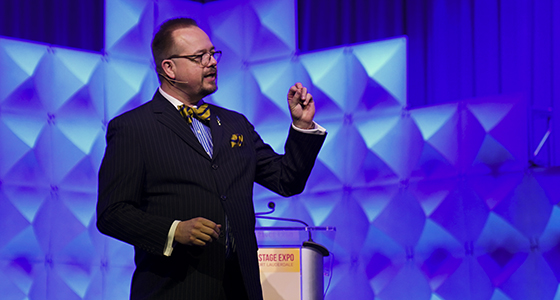By: David Grindle, USITT Executive Director
June 21, 1969
Metropolitan Opera House, New York City
This was the date of “Visions in Space,” a one-day seminar on scenic projection sponsored by USITT. You can read all about it in the May 1970 issue of Theatre Design & Technology (TD&T), and it is fascinating.
The stage at this symposium was filled with the who’s who of the day. Jo Mielziner, James Santandrea, Richard Thompson, and Ralph Alswang, among others all discussed the latest innovations in projected scenery. They acknowledged that the concept had been around since the 1930s but that the advances in projection in the 1960s brought exciting new possibilities.
Alswang stated “Who made the law that a projection is something that must be on a cyclorama? I have never seen it put on another plane, but why isn’t the use of projection in the theatre three-dimensional or two-dimensional? …There is architecture in the surfaces that we are using for projection. Obviously, that architecture is the floor, the ceiling, the sides, the front, the back, and through the actor; it is not necessarily a cyc. …[In the living screen] The audience doesn’t know when the slide projector is off or on because in fact it is totally wrapped into the scenery as we know it.”
Those words from the summer of 1969 led us 50 years later to the symposium that just concluded last week in Binghamton, New York. The Digital Media Symposium, 50 years after the first USITT offering, was finally able to explore Alswang’s desire of using architecture as a surface to explore the world of digital mapping and media for the stage.
I was fascinated to read the transcript of this seminar as they were asking many of the same questions we are asking today. How do we work to integrate the image into the world that the performer inhabits and the audience experiences? How do we use technology as an artistic tool, a digital paintbrush and paint, so to speak, as part of a collaborative art form? While the tools have changed, the central tenant of collaboration to create a world into which the viewer is drawn has remained.
As one of the keynote speakers for this year’s symposium noted in our conversation, “I am always working to make sure the digital work is not noticed but is part of the whole of the world.” That level of collaboration leads most designers to revel in the relative obscurity that is afforded them by the press and the theatre-going public. Because creating the world that is so real nothing stands out is what we are striving for.
I’m writing this just days before the Digital Media Symposium kicks off. But after reading the words of 50 years ago, I’m so excited to hear the conversations that are coming up. To hear artists and technicians discussing the finer points of painting with light. To hear people discuss using technology to tell stories on a grand scale and make viewers go on a journey that transforms the world they know, even for an instant.
In that same seminar, James Santandrea noted, “There may be a third theatre looming on the horizon. In fact, some of these productions — using large scale projection — may not work. It is my opinion that they don’t even work in the theatre houses that are structured today. That is a serious and sobering possibility.”
I can only imagine that the large scale mapping projects of the LUMA festival and others are the third theatre he was speaking of. But now that we’ve embraced that, we must also embrace the equally sobering fact that new kinds of theatre are continually developing with the advent of technology. I can’t wait to see where we go from here.
